
East Berlin was the de facto capital city of the German Democratic Republic from 1949 to 1990. Formally, it was the Soviet sector of Berlin, established in 1945. The American, British, and French sectors were known as West Berlin. From 13 August 1961 until 9 November 1989, East Berlin was separated from West Berlin by the Berlin Wall. The Western Allied powers did not recognise East Berlin as the GDR's capital, nor the GDR's authority to govern East Berlin. On 3 October 1990, the day Germany was officially reunified, East and West Berlin formally reunited as the city of Berlin.
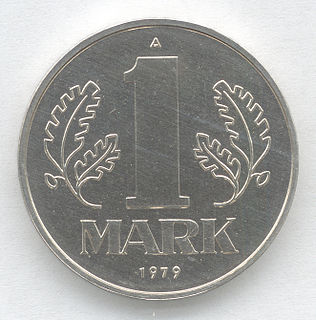
The East German mark, commonly called the eastern mark(Ostmark ) in West Germany and after the reunification), in East Germany only Mark, was the currency of the German Democratic Republic. Its ISO 4217 currency code was DDM. The currency was known officially as the Deutsche Mark from 1948 to 1964, Mark der Deutschen Notenbank from 1964 to 1967, and from 1968 to 1990 as the Mark der DDR. It was divided into 100 Pfennig (Pf).

The Palace of the Republic was a building in Berlin that hosted the Volkskammer, the parliament of the German Democratic Republic, from 1976 to 1990.

The culture of East Germany varied throughout the years due to the political and historical events that took place in the 20th century, especially as a result of Nazism and Communism. A reflection on the history of arts and culture in East Germany reveals complex relationships between artists and the state, between oppositional and conformist art. In four decades, East Germany developed a distinct culture and produced works of literature, film, visual arts, music, and theatre of international acclaim. Popular culture specialities included among others a high popularity of nudism in Eastern Germany.

Karl-Marx-Allee is a monumental socialist boulevard built by the GDR between 1952 and 1960 in Berlin Friedrichshain and Mitte. Today the boulevard is named after Karl Marx. It should not be confused with the Karl-Marx-Straße in the Neukölln district of Berlin.

The football league system of the German Democratic Republic existed from 1949 until shortly after German reunification in 1991.
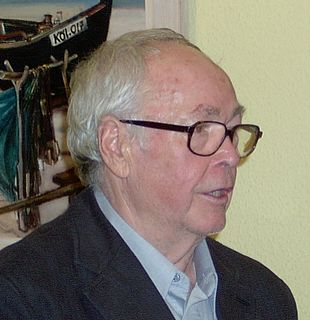
Walter Womacka was a German Socialist Realist artist. His work was pioneering early German Democratic Republic (GDR) aesthetics.
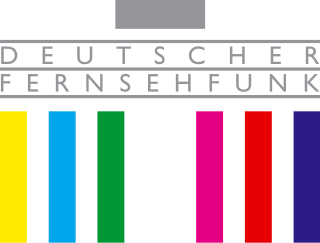
Deutscher Fernsehfunk was the state television broadcaster in the German Democratic Republic from 1952 to 1991.
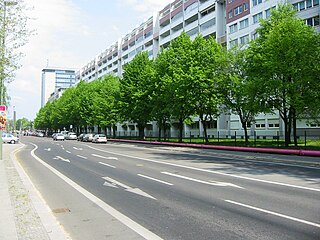
The Straße der Pariser Kommune is a street in Friedrichshain, Berlin, Germany. It was known as Fruchtstraße until March 17, 1971, when it was renamed to commemorate the 100th anniversary of the Paris Commune.

Central Stadium was a stadium with a capacity of 120,000 in Leipzig which was initially used for matches of SC Rotation Leipzig.

The Monday demonstrations in East Germany were a series of peaceful political protests against the government of the German Democratic Republic (GDR) that took place in towns and cities all around the country on various days of the week. The Leipzig demonstrations, which are the most well known, took place on Mondays. The protests that occurred between 1989 and 1991 can be separated into five cycles.
Hermann Weber was a German historian and political scientist. He has been described as "the man who knew everything about the German Democratic Republic".

The Berlin Stalin statue was a bronze portrayal of the Soviet leader Joseph Stalin. A Komsomol delegation had presented the sculpture to the East Berlin government on the occasion of the Third World Festival of Youth and Students in 1951. The monument was formally dedicated on 3 August 1951 after temporarily placement at a location on a newly designed and impressive boulevard, Stalinallee, being constructed at the time in what was then the Berlin district of Friedrichshain. Stalin monuments were generally removed from public view by the leadership of the Soviet Union and other associated countries, including East Germany, during the period of De-Stalinization. In Berlin the statue and all street signs designating Stalinallee were hastily removed one night in a clandestine operation and the street was renamed Karl-Marx-Allee and Frankfurter Allee. The bronze sculpture was smashed and the pieces were recycled.

Edmund Collein was an East German architect and urban planner. He is also known for his photography while studying at the Bauhaus art school.

The East German Republic Day Parade of 1988 was a parade on Karl-Marx-Allee in East Berlin on October 7, 1988 commemorating the 39th anniversary of the establishment of East Germany. Minister of Defense of the GDR Army General Heinz Kessler inspected the parade and Army General Horst Stechbarth commanded the parade as the Deputy Minister of Defense. The leader of East Germany Erich Honecker and the Prime Minister of the GDR Willi Stoph attended the parade. The Central Band of the National People's Army performed the military marches.
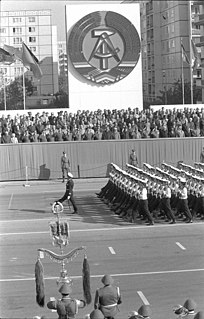
The East German Republic Day Parade of 1984 was a parade on Karl-Marx-Allee in East Berlin on October 7, 1984 commemorating the 35th anniversary of the establishment of East Germany. Soviet Foreign Minister Andrei Gromyko attended the celebrations.

The East German Republic Day Parade of 1989 was a parade on Karl-Marx-Allee in East Berlin on 7 October 1989 commemorating the 40th anniversary of the establishment of East Germany. This was the last East German Republic Day Parade and the last major East German political event with the regime falling mere weeks later. In Germany, this parade is remembered as the end of "the great period of military parades".

Adolf Hennecke, was an official of the German FDGB and of the Socialist Unity Party of Germany. He gave his name to the Hennecke movement, the German Democratic Republic's Stakhanovite activist movement.

Republic Day was an official holiday in East Germany, celebrated annually on 7 October from 1949 to 1989. Republic Day commemorates the anniversary of the establishment of the German Democratic Republic on 7 October 1949. On Republic Day, the Government of the GDR awarded many people the National Award of the GDR.

Horst Stechbarth was an East German politician and high-ranking military officer in the National People's Army, holding the rank of Army General (Armeegeneral). He was the Chief of the NVA's Landstreitkräfte and the ex officio Deputy Minister of Defense of the GDR. He was also a member of the Politbüro of the Central Committee of the ruling Socialist Unity Party of Germany (SED).
























